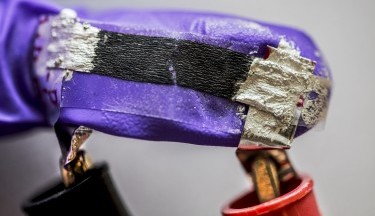Carbon nanotubes transform toilet paper into disposable sensors
February 19, 2018
on
on

In our series of articles about advances in sensor design and disposable electronics, this one is about using paper towels as base material for disposable sensors. It may sound strange, but this feat has been achieved by researchers from the University of Washington. The toilet paper sensor is light, flexible and inexpensive, and has potential applications in health care, entertainment and robotics.
In their research, the scientists used paper similar to toilet tissue. The paper – nothing more than conventional paper towels – is soaked in water holding carbon nanotubes (CNTs), making it conductive.
When stretching the conductive CNT paper its cellulose fibres experience straightening, stiffening, and fracture. The fibres originally in line with the stretching force break while those inclined and perpendicular to it are reorganized to form crossbar junctions in the vicinity of a crack. Such junctions exhibit piezoresistive and capacitive sensitivity to the out-of-plane force that can be measured.
A sensor constructed this way is capable of detecting heartbeat, finger forces and movements, eyeball movement and more, but, according to the researchers, the major innovation is a disposable wearable sensor made with cheap tissue paper.
The potential applications of the paper sensor that the scientists manage to come up with are monitoring a person’s gait or eye movement to inspect brain function or a game player’s actions. The sensors could also be used in occupational therapy for seniors. Curiously, intelligent toilet paper was not among the possible applications listed.
Photo: Dennis R. Wise/University of Washington
In their research, the scientists used paper similar to toilet tissue. The paper – nothing more than conventional paper towels – is soaked in water holding carbon nanotubes (CNTs), making it conductive.
When stretching the conductive CNT paper its cellulose fibres experience straightening, stiffening, and fracture. The fibres originally in line with the stretching force break while those inclined and perpendicular to it are reorganized to form crossbar junctions in the vicinity of a crack. Such junctions exhibit piezoresistive and capacitive sensitivity to the out-of-plane force that can be measured.
A sensor constructed this way is capable of detecting heartbeat, finger forces and movements, eyeball movement and more, but, according to the researchers, the major innovation is a disposable wearable sensor made with cheap tissue paper.
The potential applications of the paper sensor that the scientists manage to come up with are monitoring a person’s gait or eye movement to inspect brain function or a game player’s actions. The sensors could also be used in occupational therapy for seniors. Curiously, intelligent toilet paper was not among the possible applications listed.
Photo: Dennis R. Wise/University of Washington
Read full article
Hide full article


Discussion (0 comments)